We created these charts as a guideline to help better understand the Menzerna polish line. Menzerna originally formulates their polishes to be used at the OEM level, which means that these polishes are used on an assembly line to remove paint defects at the factory on fresh paint. Often these polishes are applied with extremely high speed pneumatic Random Orbital Polishers. Many times the polishes are tweaked to meet specific factory requirements based on the exact paint system, assembly line speed, and geographical location/ environmental conditions..
In 2002 Proper Auto Care sought to bring Menzerna to the US enthusiast market. At this time Menzerna`s United States distributor was focusing on the OEM market. Proper Auto Care struck a licensing agreement with Menzerna of Germany to import the polishes and expand the product line. All of Menzerna`s OEM polishes where diligently tested. The best products for the end user market: Pos34a (Power Gloss),PO91e (Intensive Polish) and PO85u (Final Polish), and PO115c (Finishing Touch Glaze) where carefully chosen to launch the line. These products, still viable today, where the most consistent preforming Menzerna polishes at the time. Proper Auto Care replaced Final Polish with PO87mc Micropolish which was appropriately renamed Final Polish II. They continue to work on all paint systems including lacquer, enamel, high solid, water based, single stage, and nano technology paints.
No one in the United States has sold Menzerna polishes to the enthusiast and end-user market longer then Proper Auto Care. It is our belief that no one has invested as much time or has as much experience in fully understanding the Menzerna product line-up. Because these polishes where OEM designed for OEM market, they can exhibit some unique characteristics in their application when used in the dynamic environments that detailers and enthusiasts face. The tools that enthusiasts and detailers commonly use, including Random Orbital, Dual-Action, and Rotary Polishers are far different the the tools used at the OEM level.
With the large number of Menzerna polishes available today there is a fair amount of overlap in each polishes function tweaked to the requirements that polish was designed to meet. Given the factors given in the preceding paragraphs, along with the infinitive variable of the polishers technique, it is impossible to create concrete charts that will be 100% accurate 100% of the time. Rather we choose to create the most in depth charts that can be used as a general guildine to help our customers better understand the wide variety of quality Menzerna Polishes offered by Proper Auto Care.
Understanding the Charts:
Polishing Range- Menzerna Polishes utilize diminishing abrasives which have greater cutting power at the beginning of the polishing cycle. As these abrasives are worked over the paint they fracture, or reduce in size and sharpness, becoming finer. This `break down` of the abrasives is what allows the polish to remove defects initially, and then as they become finer, polish the surface to a high gloss. Many factors effect the range the polish has, the most important two being the paint itself and the pad it is applied with. These charts are coded to specific Lake Country polishing pads, they show the initial cut of the polish and the types of defects that can be removed from typical paint systems, to the typical level the polish will finish at, or what types of defects will remain when the polish is fully exhausted and the abrasives have spent.
There are so many factors involved in paint polishing and so many factors that enthusiasts and detailers face that are different then the OEM level that these charts serve as a general, but thorough guideline.
Paint Condition/ Grit Level- The goal of polishing paint is to make it as microscopically smooth or level a possible. The smoother the paint is, the more gloss it has as light is evenly reflected away. Uneven, damaged, or scratched paint acts to refract or scatter light which causes a loss of potential gloss. On our scale, the higher the number, the more damaged or uneven the paint is, requiring more aggressive polishes and pads to smooth it out efficiently. Paint that is in very poor condition, scale 12-10, is very uneven and heavily damaged. The defects range in depth that would be seen if a piece of 1200-2000grit was rubbed into the surface.
Paint that is in a condition between 9-6 would have fairly moderate damage that would equal the depth caused by roughly 2200 to 3500 grit particles being rubbed against the paint`s surface. Road grime that is heavy wiped into the surface or dirty brushes at a drive through car wash would typically cause this type of marring. These would constitute typical deep swirl marks.
Paint that is in condition between 5-2 would have moderate to light defects, such as wash induced marring or dust damage. The depths of defects would range from 4000 grit to a hypothetical 10,000 grit and should require very light polishing techniques to remove. Paint that is level two may appear perfect or near perfect and have excellent gloss. It is very possible to have paint in the range of 2 to 3 that will have no visible (macroscopic) defects.
Paint ranges below 2 deal with hypothetical grit numbers for comparison and for the most part microscopic defects that rob the slightest amount of gloss from the paint. The grit numbers range from 10,000 to 40,000 grit. Paint can never be truly perfect, at the microscopic level there slight differences in height. The grit numbers are solely to illustrate that even when paint looks perfect it can be refined finer and finer in order to achieve slight levels of gloss improvement. Wiping a fresh, plush, clean microfiber towel against clean paint will at some level impart some slight amount of scratching on the paint`s surface at the microscopic level. To the naked eye we will see no loss of gloss, but science tells us that it does exist. We estimated this type of near impossible to detect super microscopic marring at 40,000 grit for reference.
Hard Paint Polishing Chart
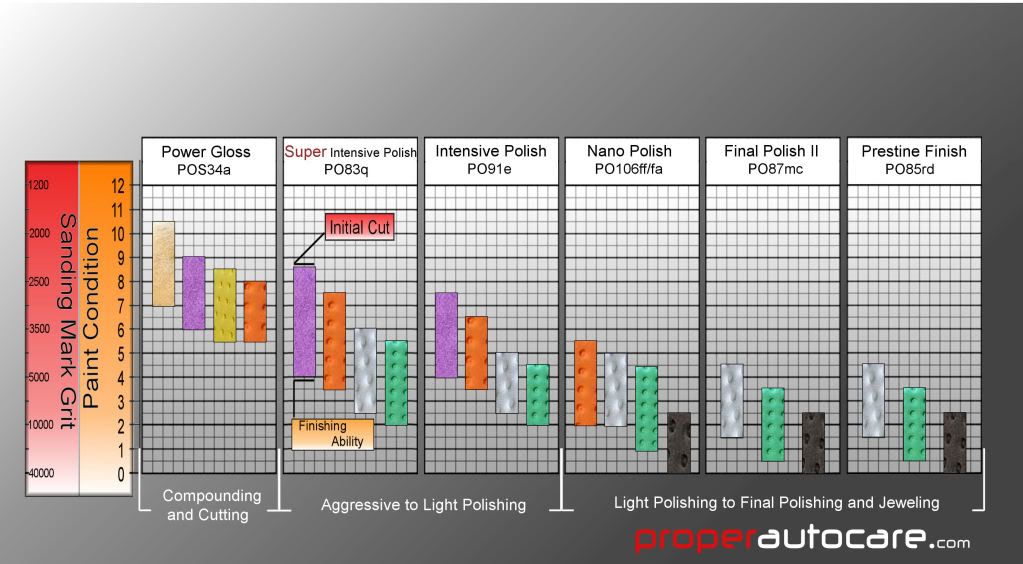
Meduim Paint Polishing Chart
Soft Paint Polishing Chart
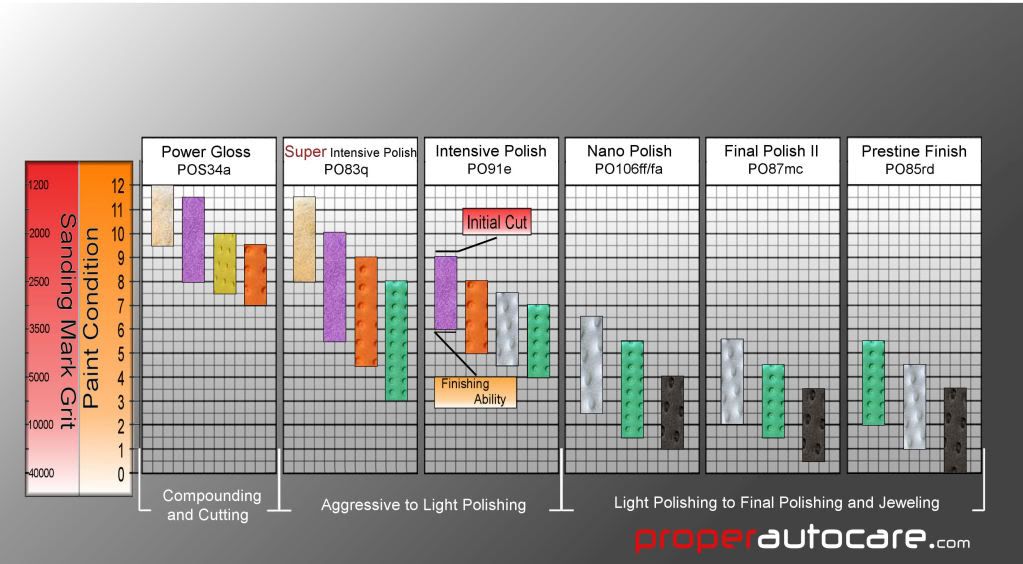
Results 1 to 15 of 56
Hybrid View
-
04-14-2009, 11:14 PM #1
Understanding Menzerna: Proper Auto Care`s guide to Menzerna!
-
04-14-2009, 11:15 PM #2
UPDATED 1/21/10: The Shine Institute
COMPOUND
POs34a Power Gloss Compound
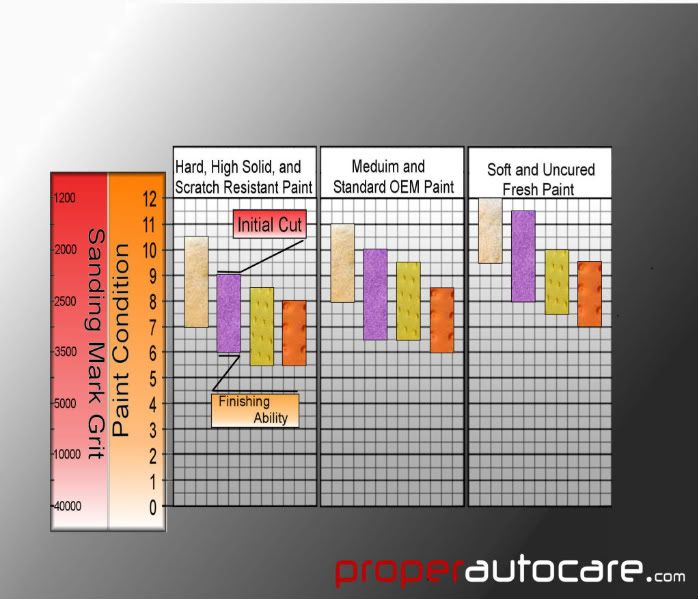
Power Gloss is a nice cutting compound that is recommended for use with a rotary polisher. Power Gloss is very effective at removing sanding scratches, deep swirl marks, and other extensive damage.
Cut: High
Finish: Moderate
Dusting: Moderate
Filling Potential: Low
Ease of Use: High
Medium Cut PolishesPO83q `Super` Intensive Polish
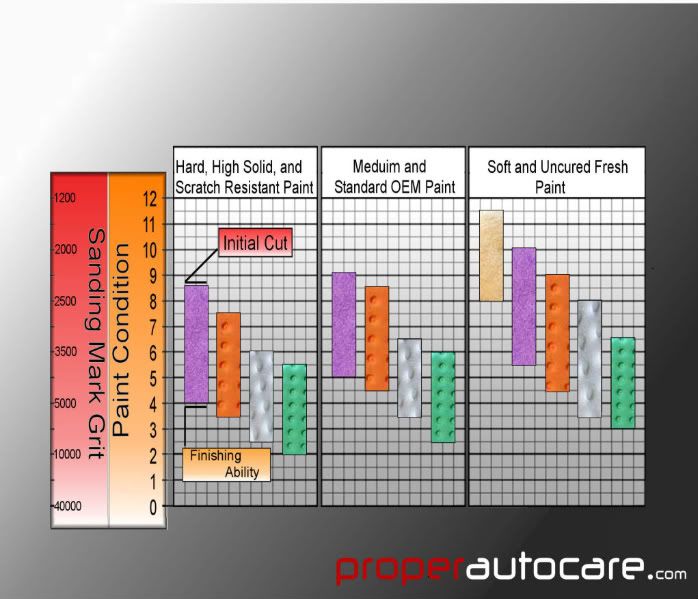
`Super` Intensive Polish is an amazing polish which can remove moderate to severe defects and finish out to super high gloss with very little swirl. `Super` Intensive Polish features a super thick lubricant which can cause problems on certain paints or in certain climates. The lubricant can be difficult to remove fully as well, leading to unintentional filling.
Cut: Moderate-High
Finish: Good
Dusting: Minimal
Filling Potential: Moderate
Ease of Use: Moderate
PO91e Intensive Polish
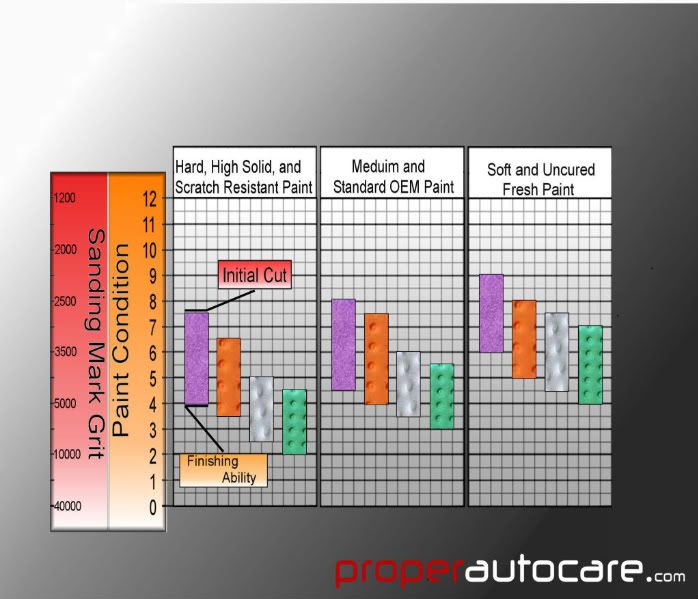
Intensive Polish is one of the original polishes introduced by Proper Auto Care in 2002. While no longer the class leader in cutting or finishing ability, Intensive Polish still has many desirable features. It will work well on all paint types, delivering consistent results with out any unwanted reactions. The dusting of the polish acts to keep spent paint from contaminating the pad, making Intensive Polish ideal for oxidized or heavily weathered paint, as well as single stage enamels and lacquers.
Cut: Moderate
Finish: Moderate-Good
Dusting: Moderate-High
Filling Potential: Low
Ease of Use: High
Final Cut Finishing Polishes
PO106ff/PO106fa106ff was Menzerna`s finishing polish answer to modern ceramic clear coats. This polish has enough cut to tackle light swirl marks and finish most paints to the highest level. The thicker lubricant system in 106ff can cause light filling and cause some issues on particularly soft paint systems. Menzerna tweaked the lubricant formula slightly to better hold the abrasives in the pad, reducing dusting, in 106fa. It should be noted that these polishes use the finest abrasive of any Menzerna polish.
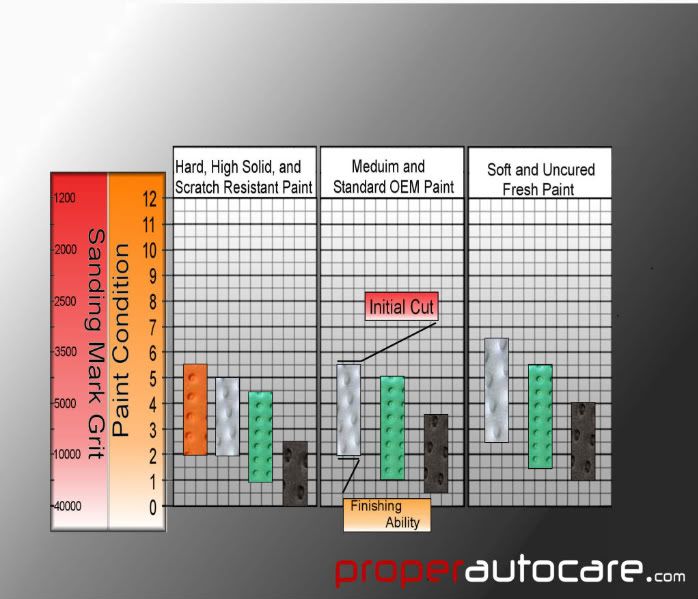
Cut: Moderate-Light
Finish: Very Good
Dusting: Moderate(106ff) Light(106fa)
Filling Potential: Moderate-Low
Ease of Use: High
PO87mc Final Polish IIPO87mc Final Polish II is a great, easy to use polish that finishes exceptionally well on all paint systems and wipes off easily. Final Polish II breaks down quicker then the other Menzerna finishing polishes, making it an ideal choice when a time deadline is near.
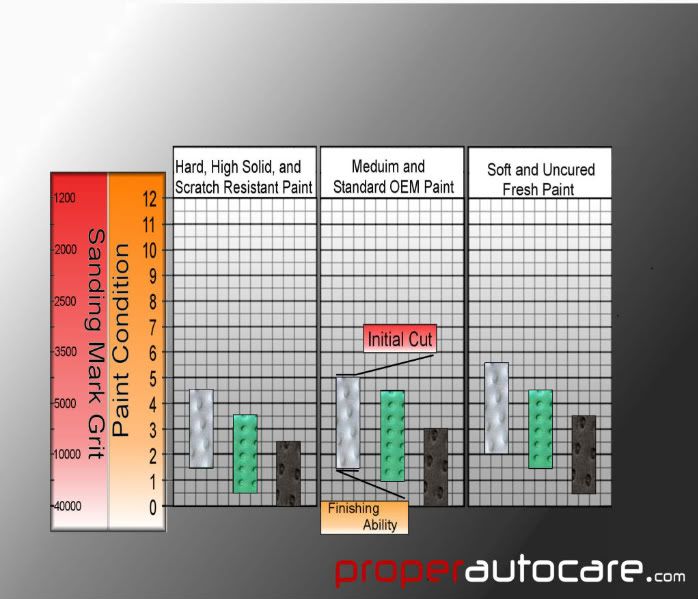
Cut: Light
Finish: Very Good
Dusting: Low
Filling Potential: Low
Ease of Use: High
PO85rd Pristine FinishEven though PO85rd was replaced by 106ff/fa in European automobile factories, detailers and enthusiast found this polish to be one of the best final step polishes in existence. It is commonly used as a `jeweling` polish to enhance the gloss of already great looking paint and create ultra sharp reflections and incredible gloss on all paint systems.
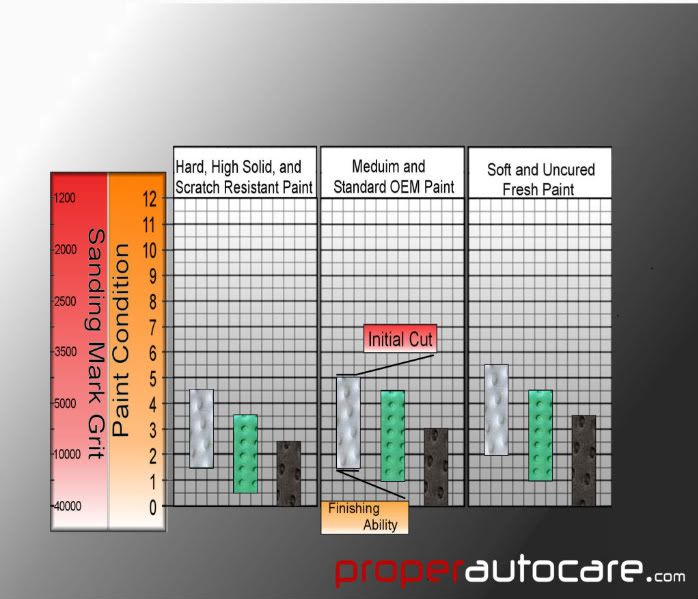
Cut: Light
Finish: Very Good
Dusting: Low
Filling Potential: Low
Ease of Use: High
-
04-15-2009, 12:33 AM #3
Wow, these are by far the best charts for Menzerna I`ve ever seen. They`re like the Rosetta Stone for deciphering which polish and pad to use. They also do a great job letting you know that it`s ok to NOT always use SIP w/LC orange or 106FA w/LC white. I feel a lot more comfortable about breaking out my PFW pads now.
So many products to try, not enough cars to try `em on...
-
04-15-2009, 09:27 AM #4
Wow, awesome charts. Too bad you couldnt post iton the "other" forum. Thanks for your time on this.
-
04-15-2009, 10:33 AM #5
This really nice to see in an easy to read format. O
thers have written encyclopedias on how to build a watch when you want to know the time.Al
Made in USA
-
04-18-2009, 05:55 AM #6TOGWTGuest
-
04-15-2009, 02:41 PM #7AutopiaForums is the place to be.
Remember to Shop Autopia-CarCare.com for your Detailing Needs!
-
04-15-2009, 03:07 PM #8
Can we get a quick clarification on the pads that are being shown in the charts? Is the purple pad the LC Purple Compounding Pad?
-
06-10-2009, 05:13 PM #9
Based on all of the discussion and charts, can I assume it would be ill-advised to use a yellow CCS pad with Intensive Polish? It`s not on the chart, but it is the only more aggressive pad I have past the orange CCS. The orange CCS with the Intensive Polish doesn`t seem to do much on my 2008 Infiniti M45, which has a sticker on the underside of the hood claiming a "hard clear coat"
-
06-10-2009, 09:15 PM #10
Proper Auto Care generally cautions against the use of a cutting pad, such as the yellow foam pad, on a dual action polisher. The aggressive nature of the pad can cause a `compounding haze` on the surface, which will temporarily dull the surface. This haze is normal, and experienced paint polishers usually don`t bat an eye at it this. However for first time polishers, this can be an uneasy feeling.
So if you are using a dual action polisher, keep in mind that stepping up to a cutting pad often adds an additional step of polishing to remove the hazing before final polishing. Again not a big deal, but often unsettling.
As far as the specific combination regarding using a yellow pad with Menzerna Intensive Polish, it shouldn`t be a problem. Intensive Polish is a more dry polish so it may dust a little more, but it could be just what you need to get the swirls out of the tough clear coat. Keep in mind that it may require you do go back over paint with Intensive Polish on either a white or orange pad to remove the `haze` before final polishing.
Todd
-
06-10-2009, 11:13 PM #11
Thanks Todd. I feel comfortable in dealing with the haze, but I appreciate the heads up on keeping with the Intensive Polish for a second round. I would have likely tried going to the FPII with a white pad. Here`s my plan of attack...let me know if you see a problem. Of course a wash and clay would come before this.
- Intensive Polish with Yellow Pad
- Int. Polish with White Pad
- FPII on a Green Pad
-
06-17-2009, 06:44 PM #12
-
04-15-2009, 09:08 PM #13
My hat is off! Though I cling to my PC, it`s nice to gauge my capabilities vs. what the pro`s can do. There`s no discounting how much the operator`s experience factors into the equation. I look forward to more articles. Thanks!
Jack
Thread Information
Users Browsing this Thread
There are currently 1 users browsing this thread. (0 members and 1 guests)
Similar Threads
-
Proper Auto Care Guide: Meguiars M105 and M205 Polish/Pad Application
By Todd@RUPES in forum Auto Detailing 101Replies: 12Last Post: 11-17-2010, 09:36 AM -
Proper Auto Care: Understanding Lake Country Polishing Pads
By Todd@RUPES in forum Machine Polishing & SandingReplies: 29Last Post: 06-05-2010, 12:39 PM -
Understanding Menzerna
By snowskate in forum Car Detailing Product DiscussionReplies: 67Last Post: 12-03-2007, 01:21 AM -
Menzerna from Autogeek & Proper Auto Care
By jgatuslao in forum Car Detailing Product DiscussionReplies: 69Last Post: 11-28-2007, 09:01 AM -
Menzerna Pad Guide
By imported_Devilsown in forum Car DetailingReplies: 4Last Post: 02-02-2007, 06:38 PM






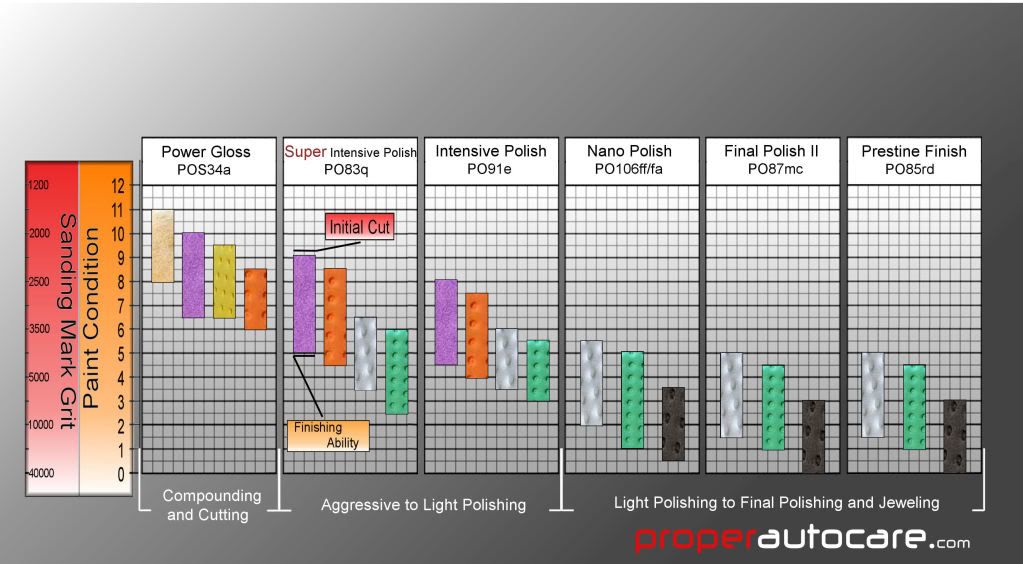

 Reply With Quote
Reply With Quote
Bookmarks